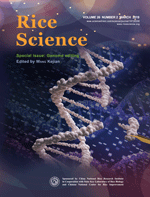Salinity is a major abiotic stress factor that seriously affects plant growth. Many genes are involved in the response to salt stress with various metabolism pathways. A number of plant transcription factor family genes have been found to be involved in the salt stress response, and NAM, ATAF and CUC (NAC) transcription factors are thought to act as active regulators during abiotic stress, especially salt stress. In this study, we detected a rice NAC transcription factor coding gene, OsNAC041, and confirmed that it influenced the germination of seeds under salt stress and salt tolerance of plants. OsNAC041 was primarily expressed in the leaves and located in the nucleus. Furthermore, the CRISPR/Cas9 method was used to obtain a targeted osnac041 mutant, of which the plant height was higher than that of the wild-type, showing increased salt sensitivity. Moreover, RNA-seq analysis revealed a number of differentially expressed genes (DEGs) involved in several important signaling pathways in the osnac041 mutant. Subsequently, Kyoto Encyclopedia of Genes and Genomes annotation also revealed differential expression of DEGs associated with mitogen-activated protein kinase signaling, peroxisome, eukaryotic- type ABC transporters, photosynthesis and plant hormones, which are involved in stress-related signaling pathways. Overall, our study suggested that OsNAC041 was involved in the salt stress response in rice. These findings not only provide empirical evidence of OsNAC041 function, but also provide new insight into its potential application in rice resistance breeding.

